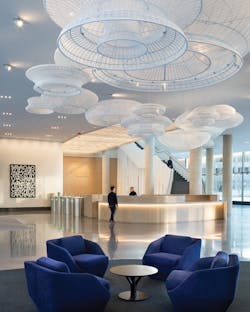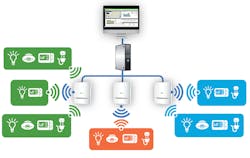GE Current Marries LED Light Fixtures and IIoT Sensors to Provide an Efficient IIoT Network Solution
Implementing an Industrial Internet of Things (IIoT) network can be daunting, especially if one does not have the existing infrastructure in place. GE Current has addressed those concerns by introducing a new way to set up an IIoT infrastructure via the use of LED light fixtures. Several businesses are beginning the transition to LED lighting in commercial and industrial buildings. While the primary goal is energy efficiency, connected lighting has the potential to modernize productivity and revenue outcomes via the benefits of IIoT networks, as well as to prepare manufacturing organizations for the future of smart systems technology. We sat down with Rudy Calderon, general manager for Industrial Accounts at GE Current, to discuss how the company is transforming the industrial manufacturing workspace—one light fixture at a time.
Rudy Calderon is the general manager for Industrial Accounts at GE Current.
What is GE Current, and what does it offer manufacturing sites?
GE Current is a business that I would say has helped transition our customers from using old technologies to ones that are cutting-edge. Our LED light fixtures help increase energy efficiency by 70% over traditional technologies and allow for the introduction of IIoT networks.
When LEDs are employed with sensor technologies, users can save another 10 to 20%. The real big opportunity we see is around business productivity, especially on the manufacturing side. We ensure that the plant is optimizing throughput; the more you can produce and ship, the better it is for the company.
When we join our sensors and fixtures, we are trying to tackle a customer’s larger issues. For example, for a manufacturing company, it is very easy to lose assets. Our architecture allows us to provide better tracking and control of the product as it goes through the plant. Our control system, Daintree, is unique because it is completely open from the top to bottom. Several of our competitors have a propriety closed system or [one that is] only open in certain aspects. This limits the growths of customers because they only grow at the pace of the system. An open system on the bottom allows our customers to procure sensors and other system products based on what they need or want to add from any supplier, not just GE.
Our methodology is that the more competitiveness there is in the marketplace, the more customers will adopt IIoT networks. The top of an open system is along the data sheets and how they control their data. They can try to manipulate the data and make their own decisions, or they can go and find independent software vendors to help them make those changes and create productivity tools. Having access to data allows our customers to figure out how the data applies and can compare it to data from other plant sites, providing unique solutions based on the manufacturing site. The data is not propriety and belongs to the customer, giving them full control to scale and make their own decisions.
The light fixtures from GE Current introduce efficient LED lighting and IIoT sensor and data collection capabilities.
IIoT implementation is happening at different levels. How do advanced LED light fixtures introduce IIoT to a plant?
Our LED fixtures allow for easy implementation of sensors across a manufacturing site, as well as introducing massive energy savings. In general, the manufacturing industrial segment LED adoption rate ranges today around 10 to 20%. There is a larger opportunity to introduce a cost-effective and easy way to introduce IIoT networks to manufacturing plants.
Each of our LED fixtures has the ability to carry a verity of sensors. Additional work does not need to be done to install sensing equipment. Fixtures don’t move. From a tracking standpoint, for example, you know that fixture 1A is not going to move from its installation location, giving customers a good bird’s-eye view of their entire manufacturing plant. A manufacturing site can install a sensor to track any assets that pass by fixture 1A and help prevent the loss of assets. Also, by using an established infrastructure of light fixtures, you don’t need to install another electrical connection network for the sensors. They can use the electricity already there. An added benefit of using LEDs is that the estimated savings of 70% will end up covering the cost of a sensor infrastructure.
What are some typical sensors that can be attached to the LED light fixtures?
There are a variety of sensors that can be attached today. This includes motion, temperature, air quality, asset tracking, noise and vibration, Bluetooth low energy, and predictive maintenance sensors. The benefit of our architecture is that with an open system, customers can use other vendors’ sensors, and that is market which grows exponentially. Just a few a years ago we probably only have half of the sensors we have today, and we expect to see more new sensors enter the market in the upcoming years.
The light fixtures can be installed in any existing lighting infrastructure and the sensors used can be from any outside vendor, as the GE Current architecture is completely open.
What are the steps necessary to update the manufacturing site’s lighting system?
Upgrading the control system is quite easy. First, you need to understand from the outside looking in what type of environment is currently being used in your plant. Whether it is—for example, metal-halide or fluorescent light fixture—you need to know what kind of light output you currently have. The second step is implementing a design that meets the lighting requirements of your space, either by OSHA or the customers’ needs. This is also where you consider the location of your light fixtures for sensor deployment, ensuring that their fixtures in key locations for either environment or asset tracking.
The third step is to agree on the price of installation once the design is complete, and then lastly is the execution of installation. In the installation phase, for every 150 fixtures, you will have a wireless area controller (WAC). The WAC collects the data from the sensors and sends it to the cloud. The contractor works with us to determine the best locations for the WACs to optimize network connectivity.
Wireless Area Controllers (WACs) collect the data from the light fixtures and upload them to the cloud.
What are the future plans for GE Current and how do you plan to expand?
We are looking to expand our IIoT LED light fixture technology to smart cities. Being able to monitor traffic and outside environments and collecting the data will help a city determine the best way to regulate the flow of a city. These are across the board from car traffic flow to helping people finding parking spots on the street…even monitoring the air quality in a neighborhood. For smart cities, the key to its future development is in the data.
Another added benefit is providing safety and security to a neighborhood. For example, there are gunshot detection sensors to help monitor crimes in a neighborhood. Our fixtures provide an easy way to collect the data over a large environment. Smart cities are going to be a large market for us in upcoming years and collecting of data will be vital there, just as it is in manufacturing plants.





